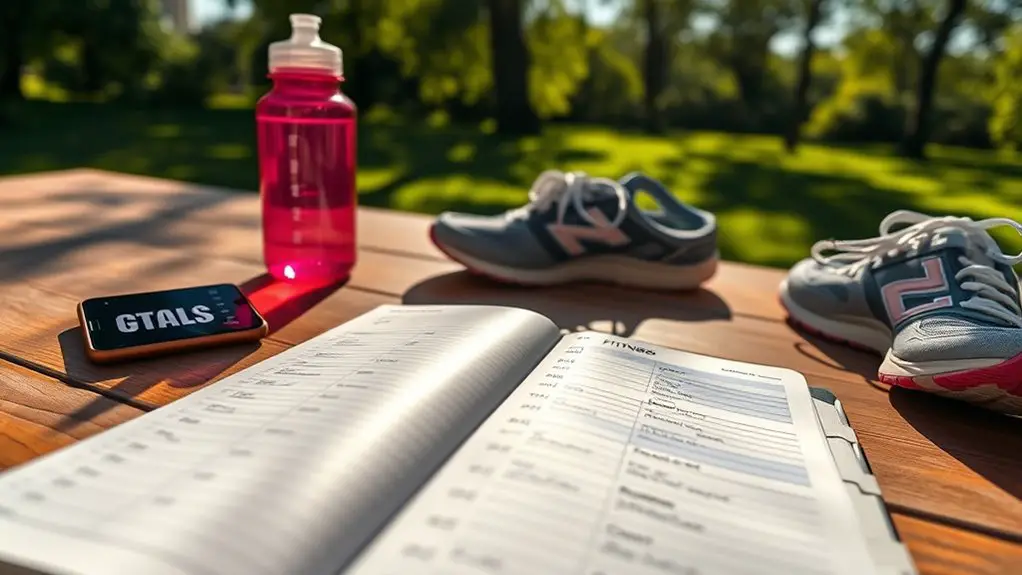How to Set SMART Fitness Goals and Stick to Them

To set SMART fitness goals, first make them Specific, Measurable, Achievable, Relevant, and Time-bound. For example, aim to walk for 30 minutes daily instead of just wanting to “get fit.” Track your progress through a journal or fitness app, and regularly assess your abilities to guarantee your goals are realistic. Keep your objectives relevant by aligning them with your interests. Stick around to discover more tips on enhancing your commitment and steering your fitness journey.
Understanding the SMART Criteria

Setting fitness goals can feel overwhelming, but understanding the SMART criteria can simplify the process. The SMART framework stands for Specific, Measurable, Achievable, Relevant, and Time-bound. By breaking your goals into these components, you can guarantee they’re not only clear but also safe to pursue.
Start by defining what you want to achieve specifically. For example, instead of saying “I want to get fit,” aim for “I want to walk 30 minutes daily.” Next, make it measurable by tracking your progress. Keep in mind that your goals should be achievable; set realistic targets that won’t risk injury or burnout. Confirm they’re relevant to your fitness motivation, connecting them to your personal well-being. Finally, set a time frame to create urgency and commitment. By following the SMART framework, you’ll transform your aspirations into actionable steps while prioritizing your safety and well-being. Additionally, regularly assess your progress indicators to ensure you’re on track to reach your goals.
Setting Specific Fitness Goals
When setting specific fitness goals, you need to define clear objectives that give you direction. It’s also important to identify measurable outcomes so you can track your progress effectively. Finally, setting wise timeframes will keep you motivated and accountable as you work towards your goals.
Define Clear Objectives
To achieve meaningful progress in your fitness journey, it’s essential to define clear objectives that focus on specific outcomes. Start by utilizing goal visualization techniques to picture your success. Break your larger goals into smaller, actionable steps to enhance motivation and keep you on track. Here’s a simple framework to guide you:
| Objective | Motivational Technique |
|---|---|
| Lose 5 pounds | Track daily food intake |
| Run a 5K | Join a local running group |
| Strength train twice a week | Set a workout schedule |
Identify Measurable Outcomes
Identifying measurable outcomes is essential for tracking your fitness progress effectively. By setting quantifiable metrics, you can evaluate your achievements and make adjustments as needed. For instance, instead of saying, “I want to get fit,” specify how many push-ups or miles you aim to run. This clarity helps you stay focused and motivated while ensuring your goals remain realistic and safe. Regularly measuring your progress allows you to celebrate small victories, which reinforces your commitment. Consider using a fitness app or journal to record your metrics, making it easier to visualize your progress tracking. Remember, the more specific your goals, the better you’ll understand your journey and the adjustments necessary for continued improvement. Stay committed, and you’ll see results!
Set Timeframes Wisely
Setting a timeframe for your fitness goals can greatly enhance your motivation and accountability. It helps you manage your time effectively and guarantees you’re making progress. Start by choosing a realistic deadline that challenges you but also allows for flexibility. Remember, life can be unpredictable, so adjust your timelines if needed to stay safe and avoid injury. Break down your larger goals into smaller milestones, which makes the journey less intimidating. This not only aids in time management but also keeps you engaged. Celebrate each achievement, no matter how small, to maintain your enthusiasm. By setting wisely structured timeframes, you’ll find it easier to stick to your fitness routine and achieve your goals safely.
Measuring Your Progress
Measuring your progress is essential for staying motivated and ensuring you’re on track to achieve your fitness goals. One effective way to do this is through progress tracking, which can help you visualize your improvements over time. Consider keeping a journal or using an app to log your workouts, nutrition, and how you feel. This will not only keep you accountable but also allow you to see what works best for your body.
Incorporating regular fitness assessments is another important step. These can include simple tests like timed runs, strength checks, or flexibility evaluations. Performing these assessments every few weeks will help you identify areas where you’re excelling and where you might need to adjust your routine.
Ensuring Your Goals Are Achievable

To guarantee your fitness goals are achievable, start by evaluating your current ability. This means being honest about what you can realistically accomplish within a specific timeframe. Setting goals that align with your capabilities will keep you motivated and on track.
Evaluate Your Current Ability
While it might be tempting to dive headfirst into ambitious fitness goals, evaluating your current ability is essential for ensuring those objectives are achievable. Start with a current fitness assessment to understand where you stand. This evaluation helps you identify your strengths and weaknesses, making it easier to create a tailored plan. Consider factors like your endurance, strength, flexibility, and body composition. A physical capability evaluation can also highlight any limitations or past injuries that may affect your progress. By knowing your starting point, you can set goals that are challenging yet realistic. Remember, safety is paramount—progressing too quickly can lead to injuries. Be honest with yourself, and set the foundation for a successful fitness journey.
Set Realistic Timeframes
Setting realistic timeframes for your fitness goals is essential, as it helps guarantee that you stay motivated and avoid burnout. When you manage your time effectively, you can break down larger goals into smaller, achievable milestones. This not only keeps you focused but also allows you to celebrate progress along the way. Prioritize your goals based on your current fitness level and available time. If you aim to run a marathon, don’t expect to be race-ready in a month—give yourself several months to build endurance safely. Remember, it’s better to set modest, realistic targets than to rush and risk injury. By practicing good time management and goal prioritization, you’ll stay on track and make certain continuous improvement in your fitness journey.
Keeping Your Goals Relevant
Keeping your fitness goals relevant is crucial for maintaining motivation and achieving long-term success. To guarantee goal alignment with your current lifestyle, regularly assess your objectives and adapt them as necessary. If you find that your interests or circumstances change, don’t hesitate to modify your goals to keep them meaningful. This flexibility can greatly enhance your personal motivation.
Consider the activities you enjoy and how they fit into your life. If you’re focusing on a specific fitness milestone, like running a 5K, but realize you prefer strength training, adjust your goals accordingly. It’s important to set goals that resonate with you and support your well-being.
Establishing a Time Frame for Success

To guarantee you stay focused and motivated, establishing a clear time frame for your fitness goals is essential. Setting deadlines creates a sense of urgency, enhancing your time management skills. When you know there’s a specific date to aim for, you’re more likely to stay committed to your plan.
Start by breaking larger goals into smaller, manageable milestones. This approach not only makes your journey feel less overwhelming but also offers opportunities for celebration along the way. For instance, if your goal is to lose 20 pounds, set a realistic timeline of 1-2 pounds per week.
Frequently Asked Questions
What if I Struggle to Stay Motivated During My Fitness Journey?
If you’re struggling to stay motivated during your fitness journey, you’re not alone. Consider finding accountability partners who can support and encourage you. Sharing your goals with someone can boost your commitment. Also, try various motivational strategies like setting small milestones or rewarding yourself for achievements. Keep your environment positive and surround yourself with encouragement. Remember, it’s okay to have ups and downs; what’s important is to keep moving forward safely.
How Can I Adjust My Goals if My Circumstances Change?
Did you know that 80% of people don’t stick to their initial goals? If your circumstances change, it’s essential to reassess your goals. Use goal reassessment strategies like breaking down larger objectives into smaller, achievable steps. Incorporate flexible planning techniques, allowing you to adapt as needed. Remember, your safety and well-being should always come first, so don’t hesitate to modify your goals to fit your current situation and maintain motivation.
Is It Okay to Have Multiple Fitness Goals at Once?
Yes, it’s perfectly okay to have multiple fitness goals at once! Just remember to use goal prioritization strategies to keep things manageable. Balancing fitness objectives can help you stay focused and motivated without overwhelming yourself. Make sure your goals are realistic and safe, and consider which ones are most important to you right now. This way, you’ll progress in a way that feels achievable and enjoyable.
What Should I Do if I Miss a Milestone?
If you miss a milestone, don’t be too hard on yourself. It’s a chance for milestone reassessment. Take a moment to reflect on what went wrong and adjust your approach. Consider involving accountability partners; having someone to share your goals with can keep you motivated and on track. Remember, fitness is a journey, and setbacks are just part of it. Stay focused on your long-term vision, and keep moving forward safely.
How Can I Celebrate My Fitness Achievements Effectively?
Celebrating your fitness achievements effectively can really boost your motivation. Consider treating yourself with fitness rewards that align with your goals, like new workout gear or a massage. Achievement recognition is key, so share your progress with friends or on social media to inspire others. Just remember to prioritize your safety; avoid overindulging in unhealthy treats. Instead, opt for a healthy celebration, like a fun outdoor activity or a nutritious meal with loved ones.





